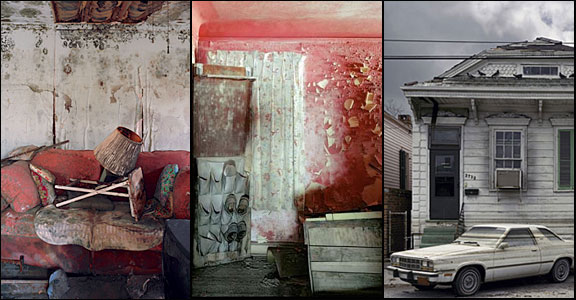 erosion
erosion
fading city

ruins
By Nicolaus Mills reference material for the floating city series

.Polidori’s New Orleans is an after-the-flood disaster of biblical proportions that continually challenges our sense of how the world is supposed to look.
Cars stand upside down, their rear bumpers leaning against the gutter of a roof. Uprooted trees rest on houses that seem as if they were built from a plywood kit. Polidori’s post-flood New Orleans is a collage of random disorder. Nothing is where it should be.
Most revealing are the domestic interiors Polidori has so carefully photographed. In “6328 North Miro Street,” a four-poster bed filled with mud looks as if it had been covered in fudge. In “North Robertson Street,” the steel blades of a ceiling fan droop like the withered petals of a flower. In “Tupelo Street,” a rack of clothes hangs neatly in a closet despite the fact that the room the clothes are in is missing its exterior wall. In “1401 Pressberg Street,” living room furniture appears as if it had been rearranged by an angry giant, while on an undamaged coffee table, a new telephone sits pristinely in its box.
in Polidori’s “New Orleans After the Flood,” we cannot make sense of anything that happened. In removing people from his photographs, in labeling houses by their street number rather than by their owners’ names, Polidori has made it clear that in his judgment Hurricane Katrina was all-powerful once it struck land. Everyone in its path was temporarily rendered anonymous.
This coerced anonymity has not prevented Polidori from emphasizing how hard Katrina was on the poor. In the interiors that he photographed, Polidori is not embarrassed to point out that so many New Orleans residents caught in the flood never owned very much in the first place. The litter that Polidori’s camera has captured is dominated by close-ups of old television sets, mismatched couches, beaten-up tables and chairs—furniture that was disposable long before it was ruined.
There is also a politics of empathy . He puts us inside the homes that the victims of Hurricane Katrina no longer occupy, leaving what should be done next to our imaginations. His bet is that we will see, as he has, that no family subjected to such trauma can be expected to restart its life without first getting the kind of help that government alone can provide for coping with disaster on this scale.